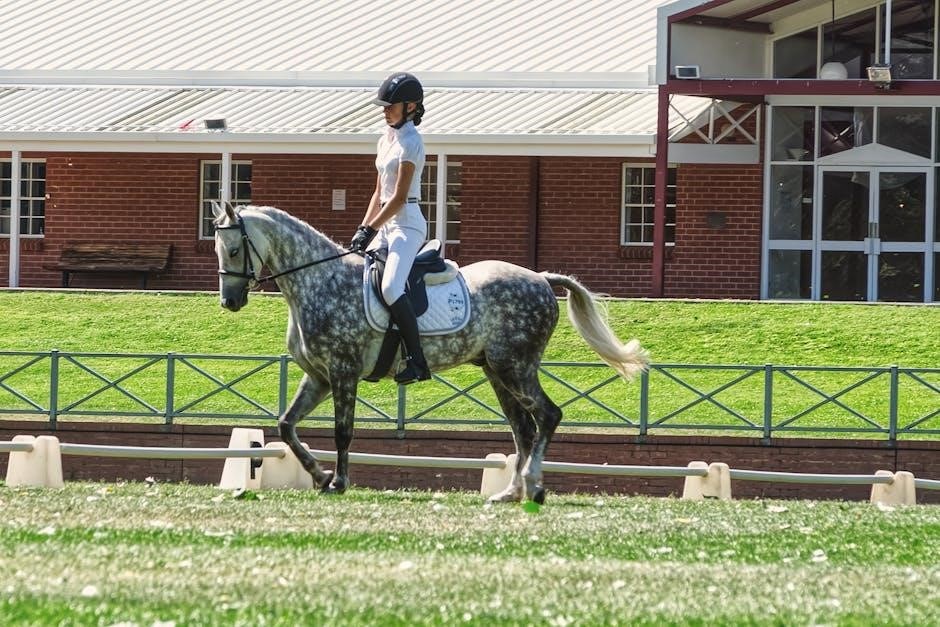The 5-4-3-2-1 grounding technique is a mindfulness tool designed to bring clarity and calm by engaging your senses. This simple yet effective method helps anchor you in the present moment, reducing stress and anxiety. Available as a PDF guide, it provides a structured approach to practicing this technique anywhere, making it accessible and easy to incorporate into daily life.
What is Grounding?
Grounding is a mindfulness technique that helps individuals focus on the present moment by engaging their senses. It’s a powerful tool to reduce anxiety and stress by creating a mental anchor to reality. Grounding techniques, like the 5-4-3-2-1 method, encourage awareness of immediate surroundings, calming the mind and body. This practice is widely used in mental health and wellness to promote emotional balance and stability. By redirecting focus to tangible sensory experiences, grounding helps individuals break free from overwhelming thoughts and regain control over their emotions. It’s a simple yet effective strategy that can be practiced anywhere, making it a valuable resource for managing daily stress and anxiety.
Overview of the 5-4-3-2-1 Technique
The 5-4-3-2-1 grounding technique is a structured mindfulness practice that guides individuals to focus on their immediate environment through their senses. Starting with identifying 5 things you can see, it progresses to 4 things you can touch, 3 things you can hear, 2 things you can smell, and finally, 1 thing you can taste. This sequential approach helps anchor the mind in the present moment, reducing feelings of overwhelm and anxiety. The technique is simple, requiring no special tools, and can be practiced anywhere. It’s often recommended as a quick and effective way to regain emotional balance. The PDF guide provides a clear, step-by-step overview, making it easy for anyone to learn and implement this powerful grounding method in their daily life.

How the 5-4-3-2-1 Grounding Technique Works
The technique works by sequentially engaging the senses to anchor the mind in the present. It starts with sight, then touch, hearing, smell, and taste, grounding you immediately.
Step 1: 5 Things You Can See
Begin by identifying 5 things you can see around you. These could be objects, patterns, or details in your environment. For example, notice a chair, a plant, a window, a book, or a specific color on the wall. Take your time to observe each item carefully, focusing on their shapes, colors, and textures. This step helps distract your mind from anxious thoughts and anchors you in the present moment. By engaging your sense of sight, you start the process of grounding and becoming more mindful of your surroundings. This visual focus lays the foundation for the subsequent steps, making the technique more effective.
Step 2: 4 Things You Can Touch
Next, identify 4 things you can touch around you. This could include the texture of your chair, the feeling of your feet on the ground, the sensation of air on your skin, or the fabric of your clothing. Engage your sense of touch by paying attention to the physical sensations these objects provide. For example, notice the softness of a blanket, the coolness of a surface, or the firmness of the ground beneath you. This step helps deepen your connection to the present moment by grounding you through physical sensations. By focusing on touch, you further distract your mind from anxious thoughts and anchor yourself in reality. This tactile engagement reinforces the calming effects of the technique, making it easier to stay focused and centered.
Step 3: 3 Things You Can Hear
Now, focus on identifying 3 things you can hear around you. These could be background noises like a fan humming, birds chirping, or people talking. Alternatively, you might notice more subtle sounds, such as the ticking of a clock, the rustling of leaves, or the sound of your own breathing. By concentrating on these auditory cues, you further anchor yourself in the present moment. This step helps distract your mind from anxious thoughts and centers your attention on the tangible sounds in your environment. The goal is to let go of mental chatter and simply observe the noises around you without judgment. This auditory focus deepens your grounding experience and enhances mindfulness.
Step 4: 2 Things You Can Smell
Next, bring your attention to your sense of smell by identifying 2 things you can smell. This could be the scent of freshly brewed coffee, the aroma of flowers, or even the subtle smell of cleaning products in the room. If you’re outdoors, you might notice the earthy smell of grass or the fragrance of blooming plants. Smell is a powerful sense that can quickly ground you in the present moment. Take a deep breath and allow yourself to fully experience these scents without judgment. This step helps further distract your mind from anxious thoughts and deepens your connection to your surroundings. By focusing on smells, you continue to anchor yourself in reality.
Step 5: 1 Thing You Can Taste
Finally, focus on your sense of taste by identifying 1 thing you can taste. This could be a piece of gum, a sip of water, or even the subtle aftertaste of a recent meal. If you’re in a place with food, notice the flavors present in your mouth. Take a moment to savor this sensation without distraction. This step helps anchor your awareness in the present moment, completing the grounding process. By engaging all five senses, you create a powerful mental anchor that brings clarity and calmness. This final step reinforces your connection to the here and now, helping you feel more centered and grounded. The simplicity of this exercise makes it highly effective for immediate stress relief.

Benefits of the 5-4-3-2-1 Grounding Technique
This technique reduces stress and anxiety by focusing on the present. It enhances mindfulness, improves emotional regulation, and can be practiced anywhere, empowering individuals to stay calm and centered.
Reduces Stress and Anxiety
The 5-4-3-2-1 grounding technique is highly effective in reducing stress and anxiety by shifting focus from overwhelming thoughts to the present moment. By engaging all five senses, individuals can calm their minds and bodies. This method is particularly useful during panic attacks or high-stress situations, as it provides a mental anchor. The structured approach of identifying sensory experiences helps distract from anxious thoughts, promoting relaxation and emotional balance. Regular practice enhances resilience against stress, making it easier to manage anxiety-provoking situations. Available in a PDF guide, this technique offers a practical tool for immediate stress relief, accessible anytime and anywhere.
Improves Mindfulness and Presence
The 5-4-3-2-1 grounding technique enhances mindfulness by encouraging individuals to focus on their immediate surroundings. By systematically engaging the senses, this method fosters a deeper connection to the present moment. Regular practice cultivates awareness, helping users become more attuned to their environment and less caught up in distracting thoughts. The technique’s structured nature makes it an excellent addition to mindfulness routines, providing a clear framework for staying grounded. Available in a PDF guide, this tool offers a practical way to improve mindfulness, making it easier to stay present in daily life and appreciate the small details often overlooked. This heightened awareness promotes emotional and mental well-being.
Enhances Emotional Regulation
The 5-4-3-2-1 grounding technique is a powerful tool for improving emotional regulation by helping individuals manage overwhelming feelings. By focusing on sensory inputs, this method distracts the mind from emotional turmoil, providing a healthy coping mechanism. It encourages users to pause and observe their surroundings, fostering a sense of control and balance. Regular practice enhances emotional resilience, making it easier to navigate challenging situations calmly. The structured nature of this technique, outlined in the PDF guide, ensures it can be applied consistently, even during intense emotional states, promoting long-term emotional well-being and stability. This makes it an invaluable resource for anyone seeking to better regulate their emotions in daily life.
Can Be Done Anywhere
The 5-4-3-2-1 grounding technique is uniquely adaptable, allowing practice in any setting, whether at home, work, or in public spaces. Its simplicity requires no special tools or equipment, making it accessible wherever you are. This technique is discreet, enabling individuals to grounding without drawing attention. For example, it can be done during a work break, while commuting, or even in the midst of a crowded area. The PDF guide emphasizes its portability, ensuring users can apply the method spontaneously to manage stress or anxiety in real-time. This versatility makes it an invaluable resource for maintaining calm and focus in diverse environments, fostering emotional resilience and stability no matter the circumstances. Its universal applicability is a key reason for its popularity among those seeking mindfulness practices that fit seamlessly into daily life.
Empowers Individuals to Stay Calm
The 5-4-3-2-1 grounding technique empowers individuals to stay calm by providing a structured method to anchor themselves in the present moment. This technique helps recenter the mind and body, especially during overwhelming or stressful situations. By focusing on sensory experiences, it interrupts anxious thoughts and promotes emotional stability. The technique serves as a mental toolkit, enabling individuals to regain control over their emotions and respond to challenges more mindfully. It fosters resilience by teaching how to manage stress effectively. The PDF guide emphasizes its accessibility, allowing anyone to practice this technique anywhere, anytime, and discreetly. This empowerment leads to improved emotional well-being and the ability to navigate life’s challenges with greater calm and confidence.

How to Practice the 5-4-3-2-1 Grounding Technique
The 5-4-3-2-1 grounding technique involves engaging your senses sequentially. Start with deep breathing, then identify 5 things seen, 4 touched, 3 heard, 2 smelled, and 1 tasted. The PDF guide provides a structured approach for easy practice.
Preparation: Finding a Comfortable Position
The 5-4-3-2-1 grounding technique begins with finding a comfortable position, either sitting or standing, to help you focus. Minimize distractions by choosing a quiet space or closing your eyes. The PDF guide emphasizes the importance of relaxation to fully engage your senses. Take a moment to adjust your posture, ensuring you feel stable and at ease. This preparation step is crucial for effectively grounding yourself in the present moment. By creating a calm environment, you set the stage for a successful practice, allowing your mind and body to connect fully with the exercise.
Starting with Deep Breathing
Begin the 5-4-3-2-1 grounding technique with deep breathing to calm your mind and body. Inhale deeply through your nose, hold for a moment, and exhale slowly through your mouth. This practice helps reduce anxiety and centers your focus. The PDF guide recommends repeating this process a few times to enhance mindfulness. Deep breathing creates a foundation for grounding, preparing you to engage your senses fully. By slowing your breath, you transition into a state of presence, making the exercise more effective. This step is essential for maximizing the technique’s benefits and fostering a calm, grounded mindset.
Engaging the Senses Sequentially
The 5-4-3-2-1 grounding technique involves systematically engaging your senses to anchor yourself in the present. Start by identifying 5 things you can see, then 4 things you can touch, followed by 3 things you can hear, 2 things you can smell, and finally, 1 thing you can taste. This sequential process helps distract the mind from anxious thoughts while fostering mindfulness. The PDF guide provides clear instructions and examples to help you navigate each step smoothly. By focusing on sensory details, you create a mental anchor, enhancing emotional stability and reducing stress. This structured approach ensures a comprehensive grounding experience, making it easier to stay calm and centered in any situation. Regular practice strengthens your ability to engage your senses effectively, deepening the technique’s benefits over time.
Duration and Frequency of Practice
For optimal results, the 5-4-3-2-1 grounding technique should be practiced regularly, ideally in short, focused sessions. Each exercise typically lasts 5 to 10 minutes, allowing sufficient time to engage all senses without feeling rushed. The PDF guide recommends starting with daily practice to build consistency and gradually increasing frequency as comfort with the technique grows. Over time, even brief moments of grounding can provide significant stress relief. Consistency is key, as regular practice enhances mindfulness and emotional resilience. By integrating this technique into your routine, you can better manage anxiety and maintain calm in challenging situations. The guide also offers tips for adapting the duration based on personal needs and preferences, ensuring flexibility for all users.

Common Variations of the 5-4-3-2-1 Grounding Technique
The 5-4-3-2-1 technique can be adapted to suit different needs and environments. One variation involves focusing on fewer items for a quicker practice. Another combines it with deep breathing exercises for enhanced relaxation. The PDF guide also suggests modifying the order of senses or incorporating visualization, making the technique versatile and accessible for various situations. These variations ensure the method remains effective and engaging for everyone, regardless of their circumstances or preferences, while maintaining its core grounding benefits. This adaptability is a key factor in its widespread popularity and effectiveness in managing stress and anxiety.
Abbreviated Versions for Quick Use
For those short on time, abbreviated versions of the 5-4-3-2-1 grounding technique offer a concise yet effective way to regain focus. These shortened exercises focus on fewer sensory inputs, allowing individuals to practice discreetly in any setting. The PDF guide often includes these streamlined methods, emphasizing efficiency without compromising effectiveness. By identifying just a couple of items from each sensory category, users can quickly ground themselves and reduce anxiety. This adaptability makes the technique accessible even during hectic moments, ensuring mental well-being is maintained with minimal effort. The abbreviated versions are particularly useful for people needing immediate stress relief, demonstrating the technique’s flexibility and practicality in real-life scenarios.
Combining with Other Mindfulness Practices
The 5-4-3-2-1 grounding technique can be seamlessly integrated with other mindfulness practices to enhance its effectiveness. For instance, pairing it with deep breathing exercises or meditation can deepen relaxation and focus. Additionally, incorporating physical practices like yoga or progressive muscle relaxation can create a holistic approach to mental and physical well-being. The PDF guide often includes suggestions for combining these methods, offering a structured way to explore their synergy. By blending grounding with other mindfulness techniques, individuals can tailor their practice to suit their needs, fostering greater emotional balance and resilience. This versatility makes the 5-4-3-2-1 technique a valuable addition to any mindfulness routine, amplifying its grounding effects and promoting long-term mental health benefits.
Adapting for Different Environments
The 5-4-3-2-1 grounding technique is versatile and can be adapted to various settings, making it accessible in any environment. Whether in a bustling city, a quiet room, or even outdoors, the technique remains effective. The PDF guide provides tips for modifying the exercise based on surroundings, ensuring it can be practiced discreetly or openly. For example, in noisy areas, focusing on visual or tactile elements can enhance grounding. In nature, the abundance of sensory inputs makes the technique particularly potent. This adaptability ensures that individuals can benefit from the 5-4-3-2-1 method regardless of where they are, offering a consistent tool for managing stress and staying present in diverse situations.

Effectiveness of the 5-4-3-2-1 Grounding Technique
The 5-4-3-2-1 grounding technique is scientifically supported and widely recognized for its ability to reduce anxiety, stress, and panic attacks. Studies highlight its proven results in improving emotional regulation and mental clarity, making it a reliable tool for maintaining psychological well-being.
Scientific Research Supporting Grounding Techniques
Scientific studies consistently support the effectiveness of grounding techniques like the 5-4-3-2-1 method. Research indicates that grounding reduces cortisol levels, alleviates anxiety, and enhances emotional regulation. The technique’s focus on sensory engagement aligns with mindfulness principles, which have been proven to improve mental health outcomes. Studies published in psychology journals highlight the immediate calming effects of grounding practices, making them a valuable tool for managing stress and panic attacks. The 5-4-3-2-1 technique, in particular, is widely recognized for its simplicity and efficacy, with many therapists incorporating it into treatment plans for anxiety disorders. Its universal accessibility and adaptability have made it a cornerstone of modern mental health strategies.
Real-Life Applications and Success Stories
The 5-4-3-2-1 grounding technique has been widely applied in real-life situations, offering tangible relief from stress and anxiety. Many individuals have reported successfully using this method during panic attacks, public speaking engagements, and high-pressure work environments. For example, a nurse shared how the technique helped her remain calm during an emergency, while a student credited it with reducing exam anxiety. The PDF guide has made this technique easily accessible, allowing people to practice it discreetly in any setting. Its simplicity and effectiveness have made it a go-to tool for mental health professionals and individuals alike, with countless success stories highlighting its ability to bring calm and clarity in moments of distress.
Comparison with Other Grounding Methods
The 5-4-3-2-1 grounding technique stands out among other grounding methods due to its structured and sequential approach. Unlike mindfulness meditation, which can be abstract, this technique offers a clear, step-by-step process. It is more accessible than progressive muscle relaxation, as it doesn’t require physical movement. The PDF guide enhances its portability and ease of use. While deep breathing exercises focus solely on respiration, the 5-4-3-2-1 method engages all five senses, making it more comprehensive. This holistic approach has made it a preferred choice for many, as it provides a grounding experience that is both effective and easy to practice in any environment, offering a unique blend of simplicity and thoroughness.

5-4-3-2-1 Grounding Technique in PDF Format
The 5-4-3-2-1 grounding technique PDF offers a portable, structured guide with step-by-step instructions and sensory exercises, making it easy to practice anywhere and integrate into daily life.
Key Features of the PDF Guide
The 5-4-3-2-1 grounding technique PDF guide is a comprehensive resource designed to help individuals master this mindfulness practice. It includes step-by-step instructions for each sensory exercise, ensuring clarity and ease of use. The guide features a clean layout with visual cues, making it easy to follow during practice. Additionally, it offers tips for incorporating the technique into daily routines and provides space for personal notes and reflections. The PDF is accessible on various devices, allowing users to practice anytime, anywhere. Its portability and user-friendly design make it an invaluable tool for anyone seeking to enhance their mindfulness and emotional well-being through this effective grounding method.
How to Access the PDF Resource
Accessing the 5-4-3-2-1 grounding technique PDF is straightforward. It is widely available on official websites, mental health apps, and digital libraries. The guide is free to download, ensuring accessibility for everyone. Users can print it for offline use, making it convenient for any setting. The PDF is designed to be user-friendly, with clear instructions and a clean layout. It is also available in multiple languages, catering to a diverse audience. Whether at home, work, or outdoors, the guide remains a versatile tool. Its compact format allows easy access on mobile devices, making it ideal for on-the-go practice. Additionally, the guide includes navigation tips for easy reference.
Using the PDF for Personal Practice
The 5-4-3-2-1 grounding technique PDF is an excellent resource for personal practice. It guides users through each step systematically, ensuring a smooth experience. The PDF includes visual aids and examples to enhance understanding. Users can use it during stressful moments to regain calm. It is recommended to practice the technique regularly, ideally in a quiet environment. The guide also offers tips for customization, allowing individuals to adapt it to their unique needs. Many find it helpful to revisit the PDF periodically to refresh their practice. Over time, consistent use can lead to improved emotional regulation and increased mindfulness. The PDF’s clarity makes it a valuable tool for both beginners and those familiar with grounding techniques. Regular practice fosters resilience and emotional balance.
The 5-4-3-2-1 grounding technique is a simple yet powerful tool to calm the mind and reduce anxiety. Regular practice enhances mindfulness and emotional well-being, offering a practical guide in its PDF format.
The 5-4-3-2-1 grounding technique offers a practical and accessible method to manage stress and anxiety by engaging the five senses. Its structured approach provides clarity and calm, making it an invaluable tool for mindfulness. Available in a PDF guide, it ensures ease of practice anywhere, offering a pathway to emotional regulation and presence. This technique empowers individuals to stay grounded, fostering resilience and mental well-being. Its simplicity and effectiveness make it a widely recommended practice for those seeking to enhance their mindfulness and reduce anxiety in daily life.
Encouragement for Regular Practice
Consistent practice of the 5-4-3-2-1 grounding technique can lead to significant improvements in emotional regulation and overall well-being. By dedicating just a few minutes daily, individuals can cultivate mindfulness and resilience, empowering them to navigate life’s challenges with greater calm. The technique’s simplicity and accessibility make it easy to integrate into daily routines, whether during stressful moments or as a proactive mental health practice. Over time, regular use can enhance one’s ability to stay grounded and focused, fostering a deeper connection to the present moment. Encourage yourself to make this practice a habit, and experience the long-term benefits of improved mental clarity and emotional balance.

Frequently Asked Questions (FAQs)
What if I struggle to find items for each step? Start with small, obvious things around you. Even simple objects count. Can this help severe anxiety? While effective for mild anxiety, consult a professional for severe cases. How soon will I see results? Many feel calmer immediately; consistent practice enhances benefits.
What If I Can’t Find Enough Items for Each Step?
If you struggle to find enough items for each step, start small. Focus on obvious or nearby objects, like a chair, a book, or even a pen. For touch, consider clothing or furniture. The goal is to engage your senses, not to find rare items. Even in sparse environments, there are always things to notice. Remember, the technique is adaptable—any detail counts. If needed, repeat items across categories or focus on subtle details like textures or sounds. The key is to stay present and creative. With practice, you’ll become more attuned to your surroundings, making it easier to find items for each step.

Can This Technique Help with Severe Anxiety?

The 5-4-3-2-1 grounding technique can be a valuable tool for managing severe anxiety by helping individuals focus on the present moment and distract from overwhelming thoughts. While it may not eliminate severe anxiety entirely, it can provide immediate relief by grounding the mind in reality. For severe cases, it’s best used alongside professional therapy or medication. The technique’s simplicity and accessibility make it a helpful addition to a broader anxiety management plan. However, if anxiety persists or worsens, consult a mental health professional for comprehensive support. This method is most effective as part of a holistic approach to mental well-being.
How Soon Can I Expect to See Results?
The 5-4-3-2-1 grounding technique often provides immediate, though temporary, relief from anxiety or stress. Many people report feeling calmer within minutes of practicing it, as it shifts focus to the present moment. Consistent practice enhances its effectiveness, with some noticing improved emotional regulation within a few weeks. Results vary depending on individual circumstances, the severity of anxiety, and how frequently the technique is used. For severe anxiety, it may not eliminate symptoms entirely but can serve as a helpful tool to manage episodes. Regular practice is key to experiencing long-term benefits and increased resilience to stress.
